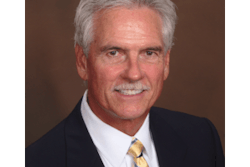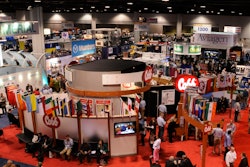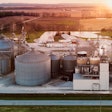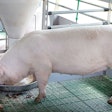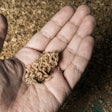J.D. Heiskell & Co., a 125-year-old grain and commodity trading business, motto says it all: “Right feed, right time, right place.” The privately held company as evolved it’s business to stay true to this promise, while maintaing the family values it touts as its foundation. The country's fourth largest feed manufacturing company by volume, J.D. Hesikell has boldly grown in order to keep up with the demands of its customer base, exceeding expectations along the way.
[Quote from chairman of the board]
“Our history proves a great deal of staying power,” says Aaron Reid, general manager/vice president, Southwest Business Group. “We’ve been in the business a long time and continue to diversify.”
Over the course of the last decade, such diversity has allowed the company to evolve from a small feed manufacturing facility in Tulare, CA to a major provider of feed, grain and commodity inputs operating livestock feed manufacturing. It boasts trans-loading facilities in seven western states in addition to its three trading offices, the business unit that facilitates the exporting grains and commodities to Mexico, the Pacific Rim and the Far East.
“Our corporate goal is to be a quality host to our customers and employees,” Reid says. “Are your customers happy to do business with you or are you just a shipper receiver? We strive to be more. We want to host their business to the point where they enjoy doing business with us and enjoy us working for them.”
The drive to expand its offerings to its customers prompted the company to journey into previously unpenetrated markets.
The Rise of the Southwest Business Group
As cattle numbers have steadily increased in destination markets, like Texas and New Mexico, J.D. Heiskell & Co. seized this potential opportunity by strategically entering the southwest market in 2006 with the acquisition of the Portales, NM grain terminal.
The Portales elevator is situated within a 150-mile radius of 1.3 million cattle and 400,000 dairy cows, allowing plenty of opportunity to supply local feed lots and dairies. The company set out to become a point of demand in the market place, trucking 150 to 200 miles around the facility.
“Entering into a new marketplace is not an easy task,” Reid says. “I think part of our success in the southwest can be attributed to the sustainability and growth [in the west] that we’ve been able to pour back into the business.”
And so the Southwest Business Group was born. With hopes to build this venture to the scale the company has achieved in California and Idaho, the group has focused first on building out its assets and securing a capable personnel base.
In 2009 J.D. Heiskell & Co. moved the group's regional office from Portales, NM to Amarillo, TX. The four merchandisers working out of the office aid in strengthening the company’s presence in the regional grain trade while securing the company's position as a feed supplier to beef cattle and dairy.
“Initially our name wasn’t as recognized in Texas and New Mexico,” says Reid. “As the business has evolved and customers have gotten to know us, it has been rewarding to see the customers satisfied with our product and customer service.”
Investing further in the market made sense — a decision aided by strategic partnerships — by expanding in Friona, TX.
Friona operations
After years of leasing a grain elevator in Friona, TX, the company purchased it in 2009. The elevator has a 2 million bushel storage capacity split between flat, steel and upright concrete structures, and will handle around 6 million bushels of corn, milo and wheat a year.
“This facility was built for local farmer origination — and have grown tremendously every year— but we’ve also moved to focus more on toward feed commodities on the outbound side,” Victor Worley, Southwest operations manager, explains.
As the ethanol industry was just coming of age and the rail lines recognized that DDGS needed to move in units as opposed to singles, J.D. Heiskell & Co. realigned its base model of business to take in large shipments of commodities. The shift toward unloading 100-car unit trains of DDGS evolved the company from country elevator to full-on trans-loading operation.
In 2007, J.D. Heiskell & Co. built its first commodity barn for DDGS. The unit train capable barn measures 140 by 360 feet with 4-foot stem walls with a capacity of 16,000 tons.
“We have been known to fill it all the way up, but I just assume see the barn half full because that means we have good sales,” Reid jokes.
As the company established itself in the region, the demand for increased capacity grew. To respond the need, J.D. Heiskell & Co. invested in a second storage barn. Mid-States Millwright & Builders built the new 140 feet wide and 400 feet long storage barn, opened for business in December 2010.
"February of 2010 brought a new aspect to the Southwest Business unit but a very familiar one for J.D. Heiskell," Reid says about the company's added bulk sales of livestock mineral supplements, silage treatment products, sack mineral sales, and professional dairy herd nutrition consulting.
新存储仓库从中间一分为二,和each side is capable of handling 20,000 tons for a total capacity of 40,000 tons.
“In order to service our customers and get the discounts from railroads, we built our first west barn the just to be able to compete,” Worley says. “We’ve been such a market presence here the last few years that’s why we built the second barn because we were able to take product in, handle it efficiently and service the customer.”
The new barn is full of two major corn byproducts: gluten feed and DDGS.
“We’re so much more marketable now because we can handle two more commodities where we didn’t have the space to do it before,” Tillery says. “In fact if we want to use smaller units, we could put several products in one bay if we wanted.”
To keep up with the volume, both barns are equipped with Hi Roller 50,000 bushel/hour belt conveyors. The conveyor’s moveable tripper’s capability is similar to what is in a concrete elevator, but rather than into a bin it efficiently feeds into the barn.
“时,越大越好grain business,” says Stephen Tillery, Friona plant manager.
The facility aims to be the first U.S. facility to dump a 100-car canola pellet train, a goal Wosley says the company should be able to achieve by February.
从第一个谷仓,建设学习the team built the second barn with higher stems walls. “Barns are as common as anything, but this barn is structurally engineered to pile a constant pile throughout,” says Tillery. “By installing a dividing wall in the middle of the barn at 200 feet, we can peak the pile and not loose capacity or air space by building a straight long pile across it.”
内部存储的谷仓,一个规模——红衣主教new facility, Fairbanks in the old — weighs the trucks prior to unloading. A camera system allows the office to better track progress at the scale, J.D. Heiskell & Co.’s propriety software system delivers the weigh-in information to the main office, and a discharge ticket is ready when the truck exits the barn.
The scale set up allows trucks are loaded out in 7 minutes — a major improvement from what it’s unload times once were.
“We’ve gone the extra mile to install a scale system so the bulk commodities aren’t fighting with the farmers coming to the elevator with their incoming crop,” Tillery explains. “By installing our scales inside the barns, we’ve alleviated that problem as it allows everyone can get their product moved and delivered in a timely fashion.”
Despite the volume and scope of the operation, the storage barns are efficiently ran by five employees.
Partnerships fueled investments
The story behind the investments goes beyond J.D. Heiskell’s ambition; it was sparked by a new relationship with Tate & Lyle to handle gluten feed pellets.
“Tate & Lyle allows us to trans-load their product for them. If we weren’t able to unload their product for them, we may not have invested in the second facility.” JDH has had a long-standing relationship with Tate & Lyle, handling its product in California since (?).
When the lease was running out on Tate & Lyle’s Amarillo facility, it sought to move out the country to a bigger facility with larger track space — J.D. Heiskell was the perfect candidate.
“Our desire to expand the business, and [CHS’s] desire to ship bigger units works to our benefit,” Worley explains. "We couldn’t put this type of project together without them having done proper business and earned their respect to want to work with us in Texas."
JDH and CHS formed a trans-loading partnership. The unloading facility delivers inbound product J.D. Heiskell’s bulk handling facilities as CHS’s leg runs into the storage barns. CHS operates a modern elevator set up on a circle track and is capable of unloading trains at 50,000 bushels/hour in 9 hours.
J.D. Heiskell & Co. maintains a great working relationship with CHS and Tate & Lyle through “over communicating” the logostics of weekly — even daily — operations.
Adding BNSF into the mix, the four players have formed a firm partnership.
"With the volume we handle, the partners we work through give us the ability to compete with the big outlets and make it work," Worley says. "We successfully compete with them heads up, and it feels good."
Investing in business
“J.D. Heiskell forward thinking outfit, we have no problems getting what we need if we can justify the need, they make it happen,” Worley says. “I’ve been in this business for 55 years and I’ve never had this luxury before.”
For example, if the employees prove that something is viable and makes money and have the right idea, the company makes it happen.
“I like the way it treats its people,” Victor says. “I appreciate having enough rope to go out there and do the job – furnish money and machinery — and respect my suggestions making this a very rewarding job.”
“Our business is set up to spend money where it needs to be spent and also advance the facility,” Reid adds.
In the future, the Southwest Business Group plans to invest in grain processing equipment at Friona, and to expand its asset base through facility acquisition or by building in to a new region.
“I’m a big believe we need to grow internally as much as we grow externally otherwise we’ll out run ourselves,” Reid says.





